University Major Project: Water Sensitive Urban Design Analysis
VerifiedAdded on 2020/05/16
|30
|7806
|218
Project
AI Summary
This project delves into Water Sensitive Urban Design (WSUD), focusing on the implementation and benefits of rainwater harvesting in urban environments. It explores the background of WSUD, its principles, and various government initiatives supporting its adoption in Australia. The project examines the water sensitivity of rainwater tanks, their lifecycle costing, and the economic, environmental, and social benefits associated with WSUD. It also addresses drivers and barriers to WSUD implementation, providing initial findings on a water-sensitive urban community project. The report analyzes different aspects of WSUD, including the management of rainwater, the reduction of water consumption, and the improvement of urban water quality. It highlights the importance of sustainable water management in urban development and offers recommendations for mitigating challenges. This project provides a comprehensive overview of WSUD, offering insights into its practical applications and its role in creating more sustainable and resilient urban environments.
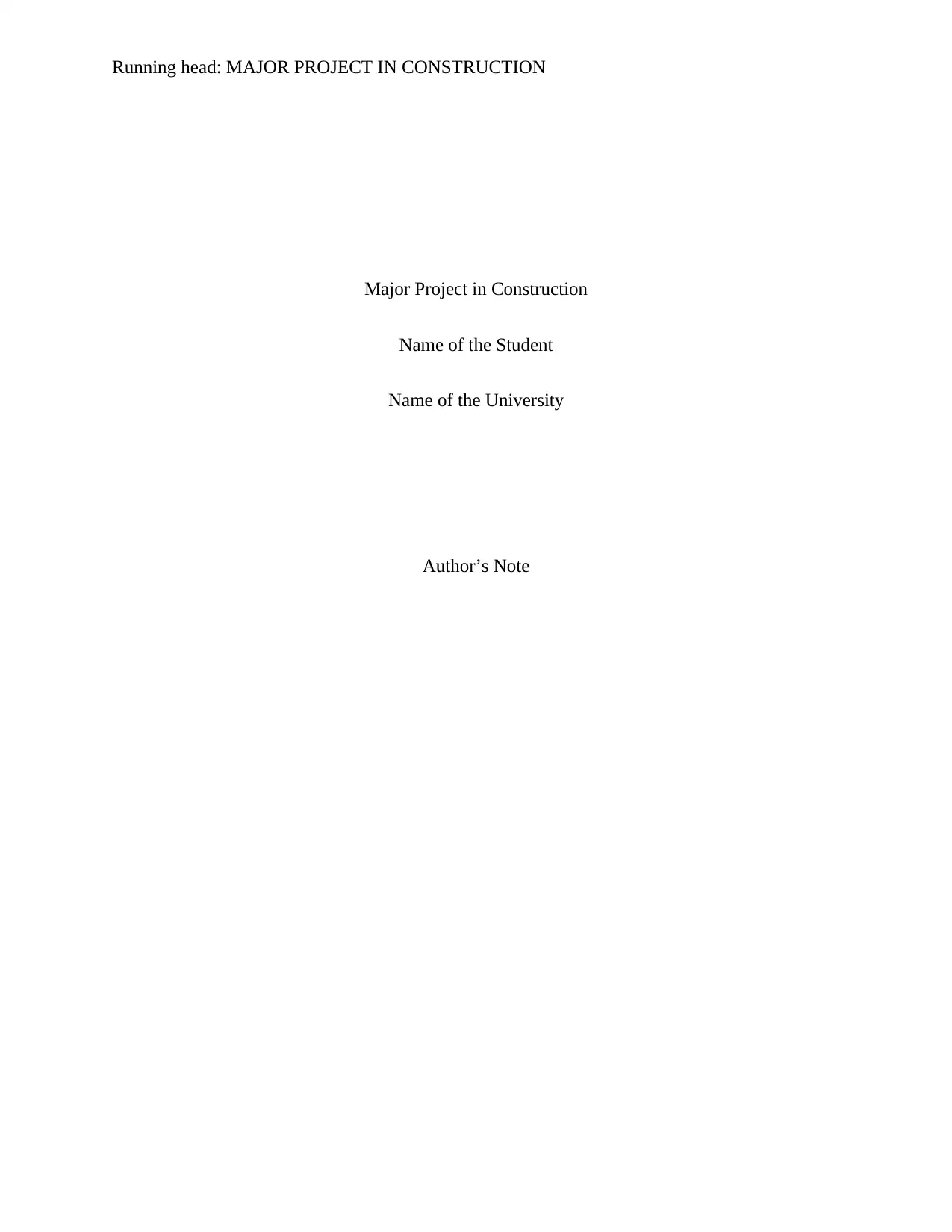
Running head: MAJOR PROJECT IN CONSTRUCTION
Major Project in Construction
Name of the Student
Name of the University
Author’s Note
Major Project in Construction
Name of the Student
Name of the University
Author’s Note
Paraphrase This Document
Need a fresh take? Get an instant paraphrase of this document with our AI Paraphraser
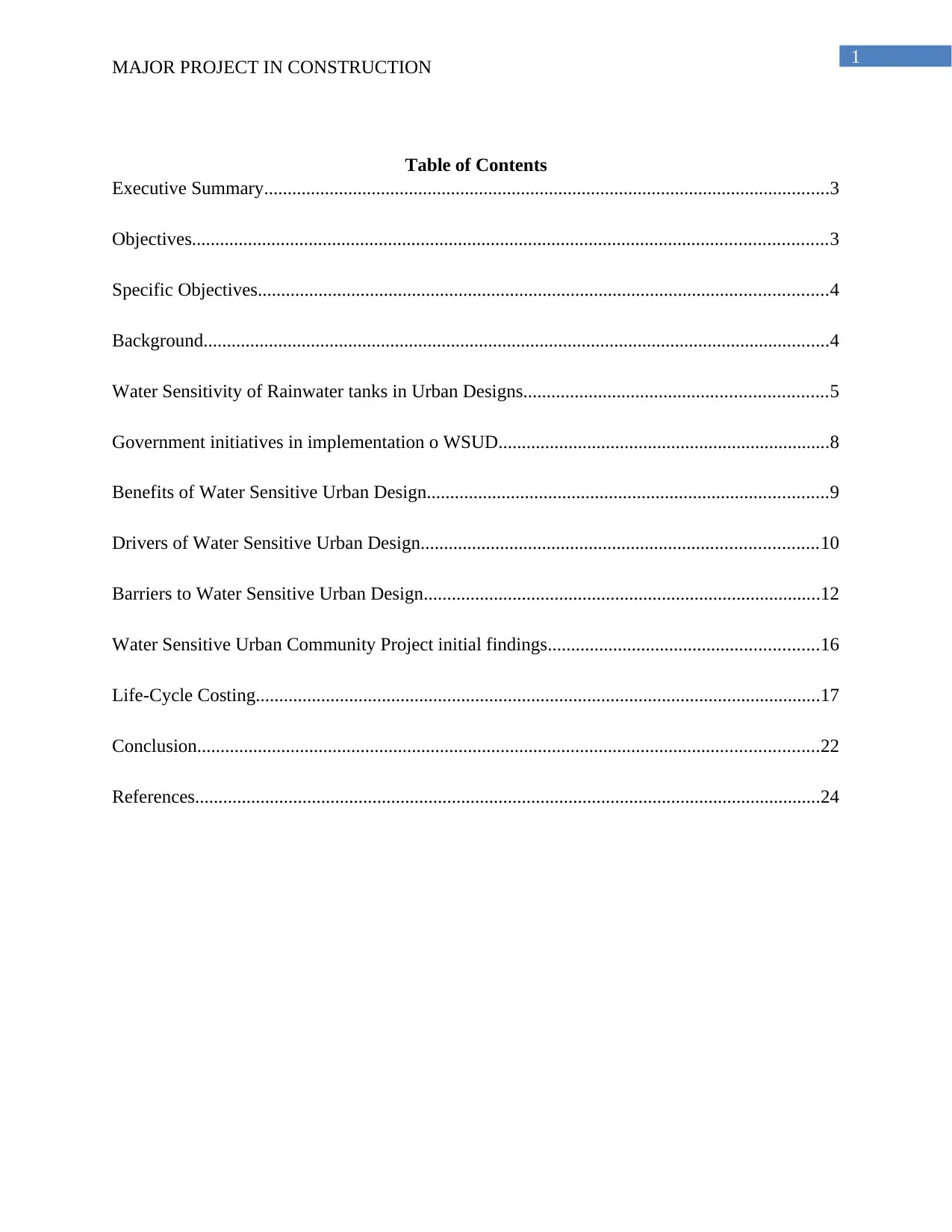
1
MAJOR PROJECT IN CONSTRUCTION
Table of Contents
Executive Summary.........................................................................................................................3
Objectives........................................................................................................................................3
Specific Objectives..........................................................................................................................4
Background......................................................................................................................................4
Water Sensitivity of Rainwater tanks in Urban Designs.................................................................5
Government initiatives in implementation o WSUD.......................................................................8
Benefits of Water Sensitive Urban Design......................................................................................9
Drivers of Water Sensitive Urban Design.....................................................................................10
Barriers to Water Sensitive Urban Design.....................................................................................12
Water Sensitive Urban Community Project initial findings..........................................................16
Life-Cycle Costing.........................................................................................................................17
Conclusion.....................................................................................................................................22
References......................................................................................................................................24
MAJOR PROJECT IN CONSTRUCTION
Table of Contents
Executive Summary.........................................................................................................................3
Objectives........................................................................................................................................3
Specific Objectives..........................................................................................................................4
Background......................................................................................................................................4
Water Sensitivity of Rainwater tanks in Urban Designs.................................................................5
Government initiatives in implementation o WSUD.......................................................................8
Benefits of Water Sensitive Urban Design......................................................................................9
Drivers of Water Sensitive Urban Design.....................................................................................10
Barriers to Water Sensitive Urban Design.....................................................................................12
Water Sensitive Urban Community Project initial findings..........................................................16
Life-Cycle Costing.........................................................................................................................17
Conclusion.....................................................................................................................................22
References......................................................................................................................................24
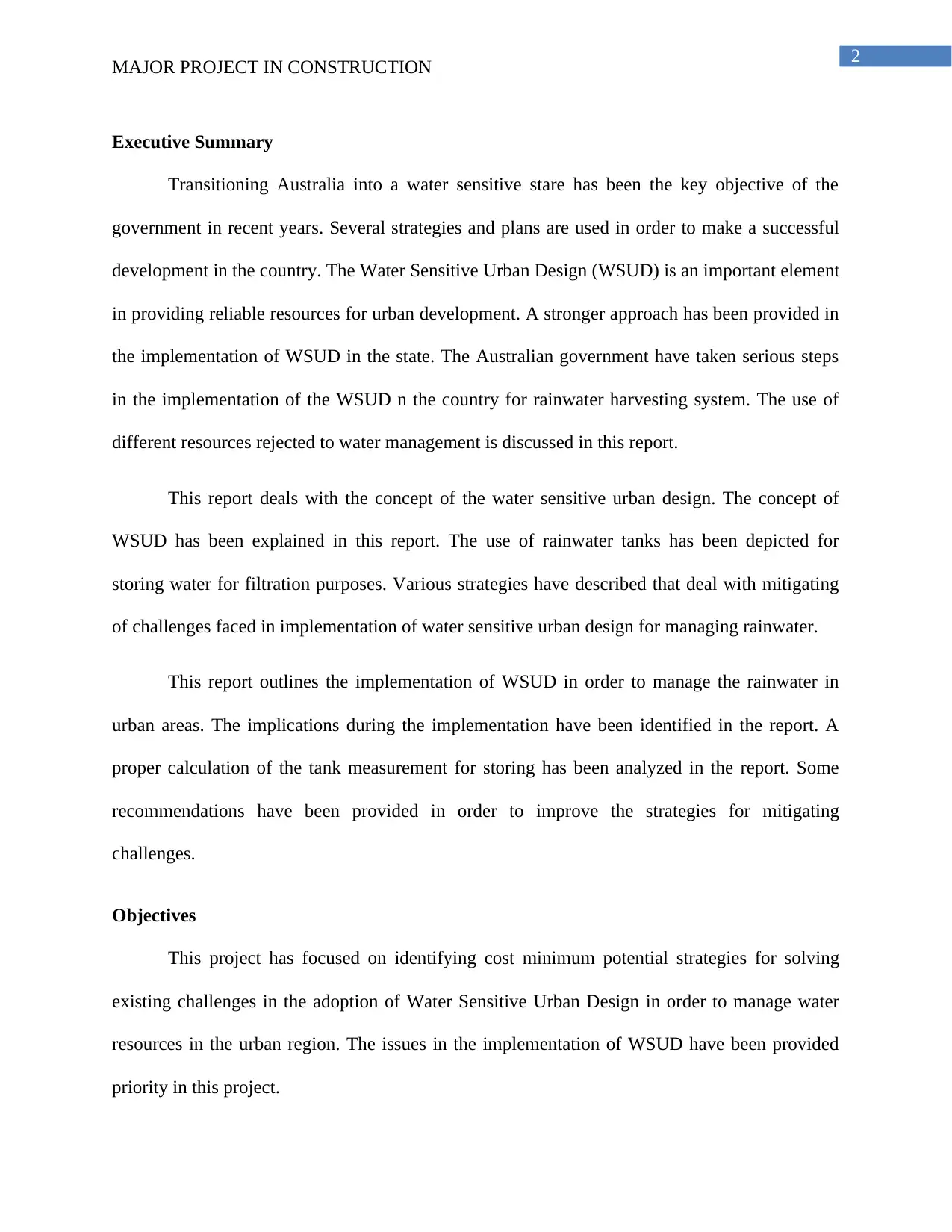
2
MAJOR PROJECT IN CONSTRUCTION
Executive Summary
Transitioning Australia into a water sensitive stare has been the key objective of the
government in recent years. Several strategies and plans are used in order to make a successful
development in the country. The Water Sensitive Urban Design (WSUD) is an important element
in providing reliable resources for urban development. A stronger approach has been provided in
the implementation of WSUD in the state. The Australian government have taken serious steps
in the implementation of the WSUD n the country for rainwater harvesting system. The use of
different resources rejected to water management is discussed in this report.
This report deals with the concept of the water sensitive urban design. The concept of
WSUD has been explained in this report. The use of rainwater tanks has been depicted for
storing water for filtration purposes. Various strategies have described that deal with mitigating
of challenges faced in implementation of water sensitive urban design for managing rainwater.
This report outlines the implementation of WSUD in order to manage the rainwater in
urban areas. The implications during the implementation have been identified in the report. A
proper calculation of the tank measurement for storing has been analyzed in the report. Some
recommendations have been provided in order to improve the strategies for mitigating
challenges.
Objectives
This project has focused on identifying cost minimum potential strategies for solving
existing challenges in the adoption of Water Sensitive Urban Design in order to manage water
resources in the urban region. The issues in the implementation of WSUD have been provided
priority in this project.
MAJOR PROJECT IN CONSTRUCTION
Executive Summary
Transitioning Australia into a water sensitive stare has been the key objective of the
government in recent years. Several strategies and plans are used in order to make a successful
development in the country. The Water Sensitive Urban Design (WSUD) is an important element
in providing reliable resources for urban development. A stronger approach has been provided in
the implementation of WSUD in the state. The Australian government have taken serious steps
in the implementation of the WSUD n the country for rainwater harvesting system. The use of
different resources rejected to water management is discussed in this report.
This report deals with the concept of the water sensitive urban design. The concept of
WSUD has been explained in this report. The use of rainwater tanks has been depicted for
storing water for filtration purposes. Various strategies have described that deal with mitigating
of challenges faced in implementation of water sensitive urban design for managing rainwater.
This report outlines the implementation of WSUD in order to manage the rainwater in
urban areas. The implications during the implementation have been identified in the report. A
proper calculation of the tank measurement for storing has been analyzed in the report. Some
recommendations have been provided in order to improve the strategies for mitigating
challenges.
Objectives
This project has focused on identifying cost minimum potential strategies for solving
existing challenges in the adoption of Water Sensitive Urban Design in order to manage water
resources in the urban region. The issues in the implementation of WSUD have been provided
priority in this project.
⊘ This is a preview!⊘
Do you want full access?
Subscribe today to unlock all pages.

Trusted by 1+ million students worldwide
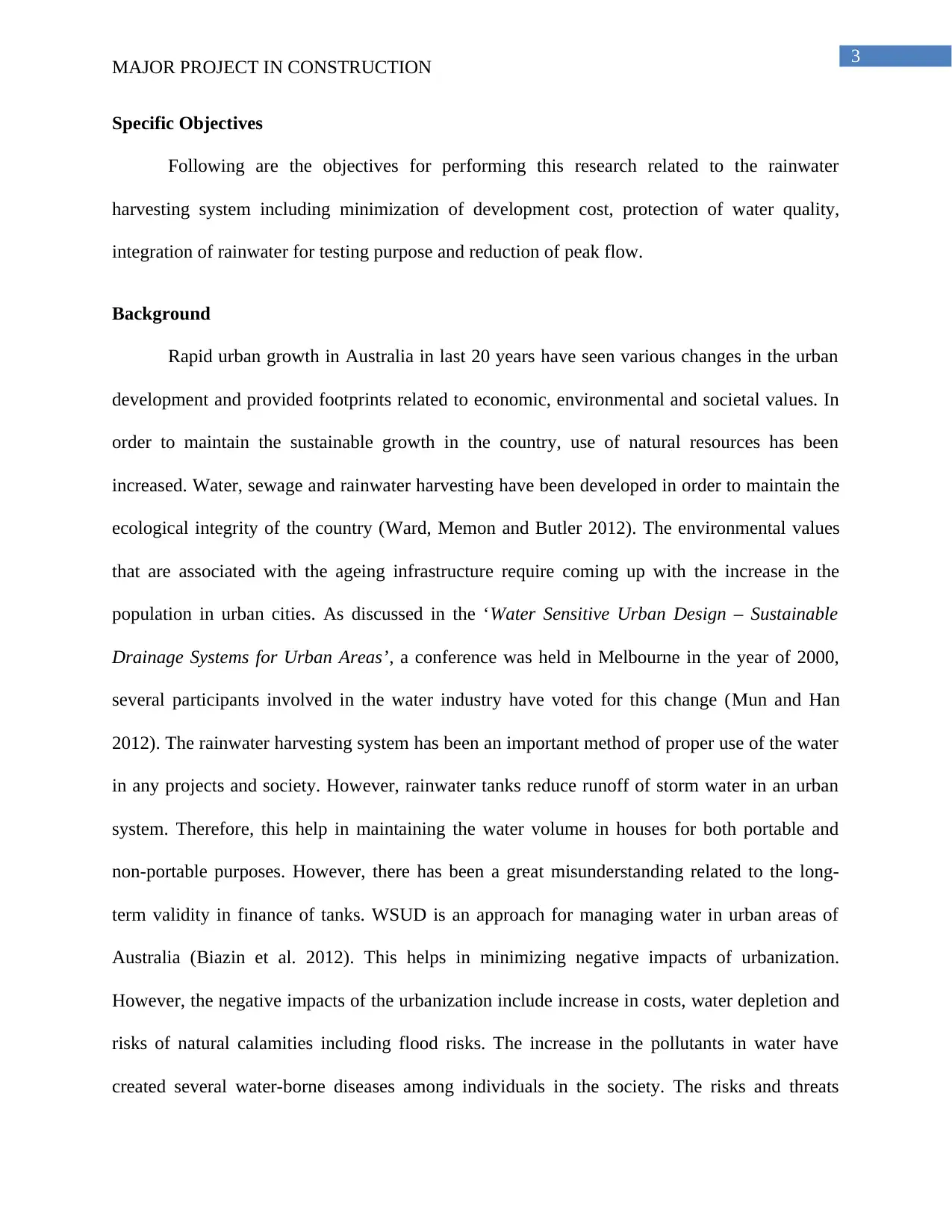
3
MAJOR PROJECT IN CONSTRUCTION
Specific Objectives
Following are the objectives for performing this research related to the rainwater
harvesting system including minimization of development cost, protection of water quality,
integration of rainwater for testing purpose and reduction of peak flow.
Background
Rapid urban growth in Australia in last 20 years have seen various changes in the urban
development and provided footprints related to economic, environmental and societal values. In
order to maintain the sustainable growth in the country, use of natural resources has been
increased. Water, sewage and rainwater harvesting have been developed in order to maintain the
ecological integrity of the country (Ward, Memon and Butler 2012). The environmental values
that are associated with the ageing infrastructure require coming up with the increase in the
population in urban cities. As discussed in the ‘Water Sensitive Urban Design – Sustainable
Drainage Systems for Urban Areas’, a conference was held in Melbourne in the year of 2000,
several participants involved in the water industry have voted for this change (Mun and Han
2012). The rainwater harvesting system has been an important method of proper use of the water
in any projects and society. However, rainwater tanks reduce runoff of storm water in an urban
system. Therefore, this help in maintaining the water volume in houses for both portable and
non-portable purposes. However, there has been a great misunderstanding related to the long-
term validity in finance of tanks. WSUD is an approach for managing water in urban areas of
Australia (Biazin et al. 2012). This helps in minimizing negative impacts of urbanization.
However, the negative impacts of the urbanization include increase in costs, water depletion and
risks of natural calamities including flood risks. The increase in the pollutants in water have
created several water-borne diseases among individuals in the society. The risks and threats
MAJOR PROJECT IN CONSTRUCTION
Specific Objectives
Following are the objectives for performing this research related to the rainwater
harvesting system including minimization of development cost, protection of water quality,
integration of rainwater for testing purpose and reduction of peak flow.
Background
Rapid urban growth in Australia in last 20 years have seen various changes in the urban
development and provided footprints related to economic, environmental and societal values. In
order to maintain the sustainable growth in the country, use of natural resources has been
increased. Water, sewage and rainwater harvesting have been developed in order to maintain the
ecological integrity of the country (Ward, Memon and Butler 2012). The environmental values
that are associated with the ageing infrastructure require coming up with the increase in the
population in urban cities. As discussed in the ‘Water Sensitive Urban Design – Sustainable
Drainage Systems for Urban Areas’, a conference was held in Melbourne in the year of 2000,
several participants involved in the water industry have voted for this change (Mun and Han
2012). The rainwater harvesting system has been an important method of proper use of the water
in any projects and society. However, rainwater tanks reduce runoff of storm water in an urban
system. Therefore, this help in maintaining the water volume in houses for both portable and
non-portable purposes. However, there has been a great misunderstanding related to the long-
term validity in finance of tanks. WSUD is an approach for managing water in urban areas of
Australia (Biazin et al. 2012). This helps in minimizing negative impacts of urbanization.
However, the negative impacts of the urbanization include increase in costs, water depletion and
risks of natural calamities including flood risks. The increase in the pollutants in water have
created several water-borne diseases among individuals in the society. The risks and threats
Paraphrase This Document
Need a fresh take? Get an instant paraphrase of this document with our AI Paraphraser
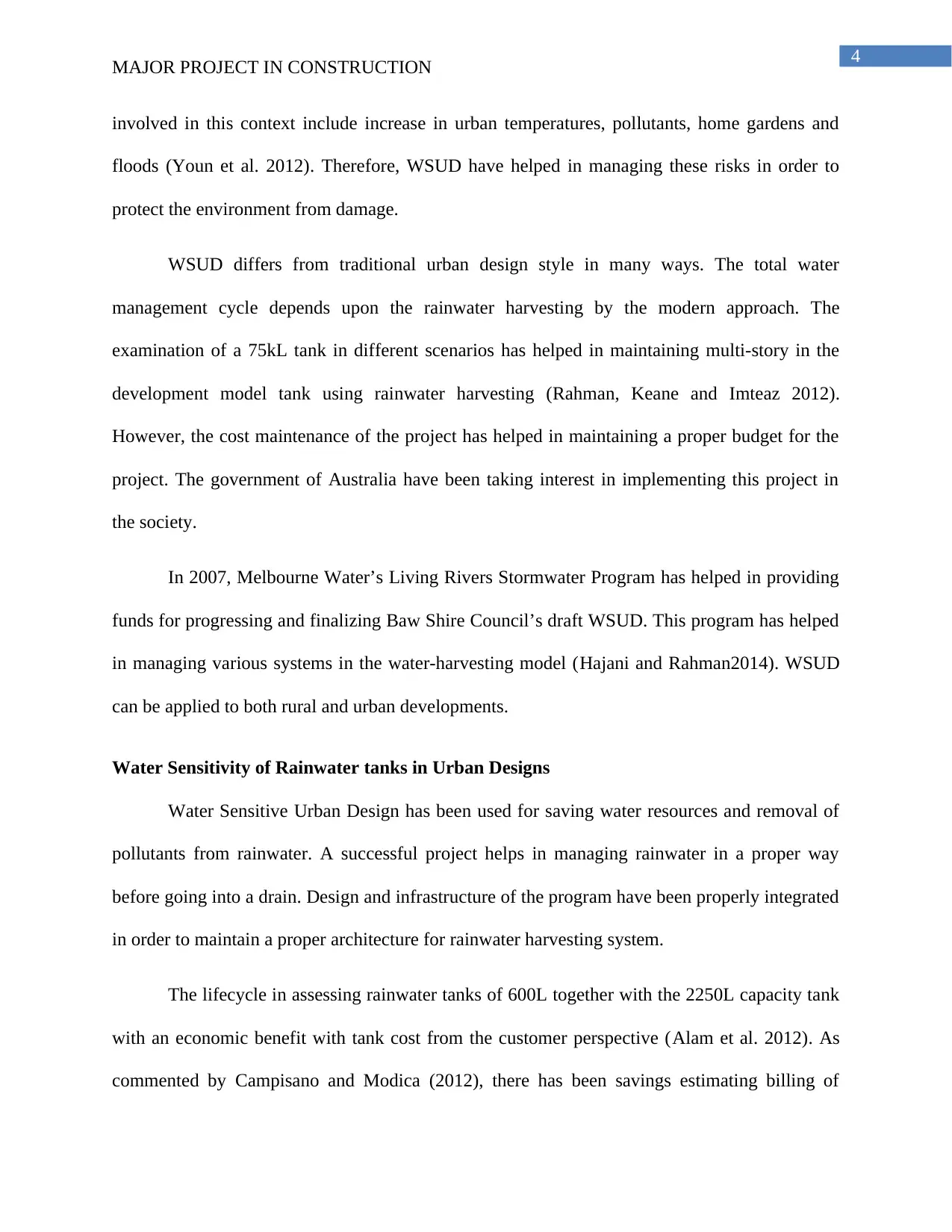
4
MAJOR PROJECT IN CONSTRUCTION
involved in this context include increase in urban temperatures, pollutants, home gardens and
floods (Youn et al. 2012). Therefore, WSUD have helped in managing these risks in order to
protect the environment from damage.
WSUD differs from traditional urban design style in many ways. The total water
management cycle depends upon the rainwater harvesting by the modern approach. The
examination of a 75kL tank in different scenarios has helped in maintaining multi-story in the
development model tank using rainwater harvesting (Rahman, Keane and Imteaz 2012).
However, the cost maintenance of the project has helped in maintaining a proper budget for the
project. The government of Australia have been taking interest in implementing this project in
the society.
In 2007, Melbourne Water’s Living Rivers Stormwater Program has helped in providing
funds for progressing and finalizing Baw Shire Council’s draft WSUD. This program has helped
in managing various systems in the water-harvesting model (Hajani and Rahman2014). WSUD
can be applied to both rural and urban developments.
Water Sensitivity of Rainwater tanks in Urban Designs
Water Sensitive Urban Design has been used for saving water resources and removal of
pollutants from rainwater. A successful project helps in managing rainwater in a proper way
before going into a drain. Design and infrastructure of the program have been properly integrated
in order to maintain a proper architecture for rainwater harvesting system.
The lifecycle in assessing rainwater tanks of 600L together with the 2250L capacity tank
with an economic benefit with tank cost from the customer perspective (Alam et al. 2012). As
commented by Campisano and Modica (2012), there has been savings estimating billing of
MAJOR PROJECT IN CONSTRUCTION
involved in this context include increase in urban temperatures, pollutants, home gardens and
floods (Youn et al. 2012). Therefore, WSUD have helped in managing these risks in order to
protect the environment from damage.
WSUD differs from traditional urban design style in many ways. The total water
management cycle depends upon the rainwater harvesting by the modern approach. The
examination of a 75kL tank in different scenarios has helped in maintaining multi-story in the
development model tank using rainwater harvesting (Rahman, Keane and Imteaz 2012).
However, the cost maintenance of the project has helped in maintaining a proper budget for the
project. The government of Australia have been taking interest in implementing this project in
the society.
In 2007, Melbourne Water’s Living Rivers Stormwater Program has helped in providing
funds for progressing and finalizing Baw Shire Council’s draft WSUD. This program has helped
in managing various systems in the water-harvesting model (Hajani and Rahman2014). WSUD
can be applied to both rural and urban developments.
Water Sensitivity of Rainwater tanks in Urban Designs
Water Sensitive Urban Design has been used for saving water resources and removal of
pollutants from rainwater. A successful project helps in managing rainwater in a proper way
before going into a drain. Design and infrastructure of the program have been properly integrated
in order to maintain a proper architecture for rainwater harvesting system.
The lifecycle in assessing rainwater tanks of 600L together with the 2250L capacity tank
with an economic benefit with tank cost from the customer perspective (Alam et al. 2012). As
commented by Campisano and Modica (2012), there has been savings estimating billing of
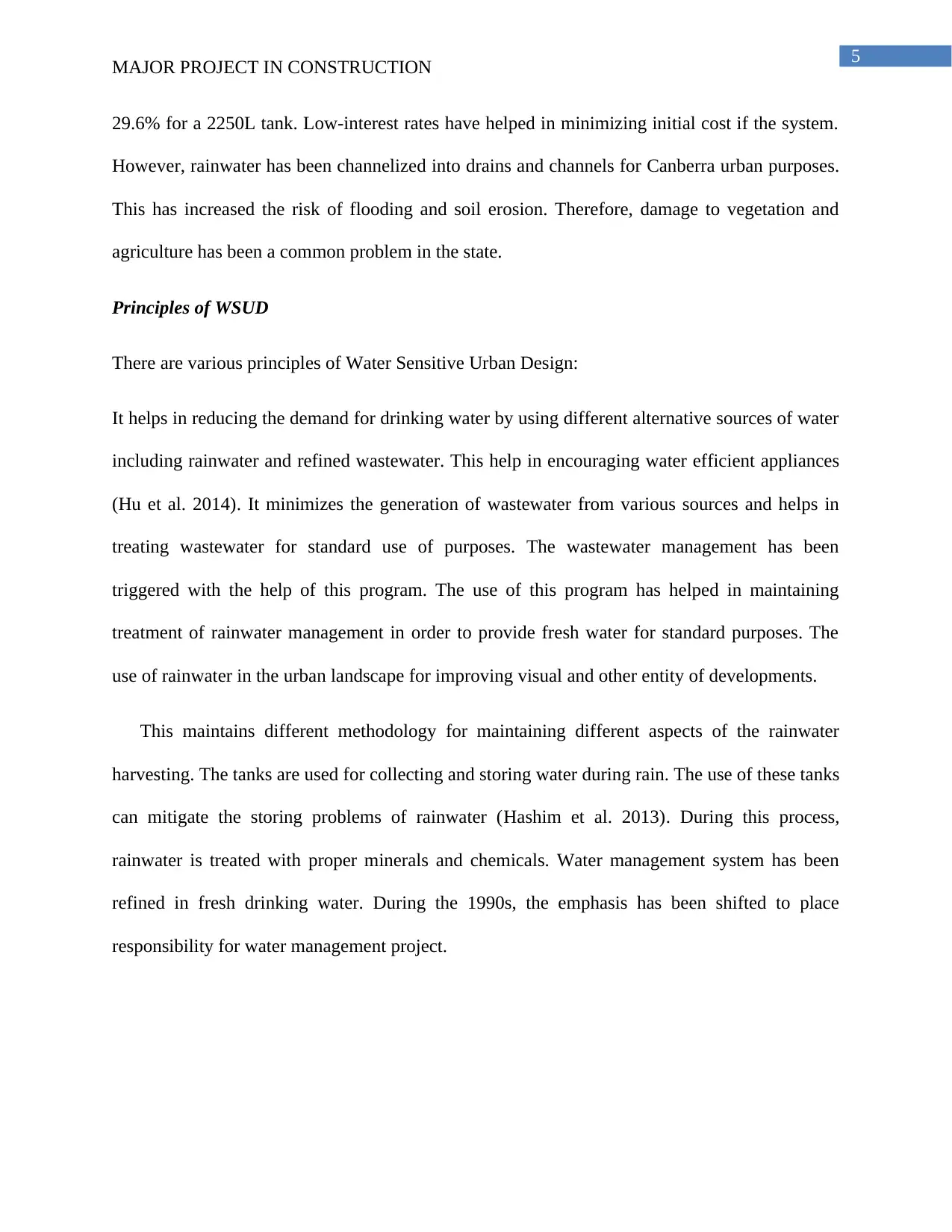
5
MAJOR PROJECT IN CONSTRUCTION
29.6% for a 2250L tank. Low-interest rates have helped in minimizing initial cost if the system.
However, rainwater has been channelized into drains and channels for Canberra urban purposes.
This has increased the risk of flooding and soil erosion. Therefore, damage to vegetation and
agriculture has been a common problem in the state.
Principles of WSUD
There are various principles of Water Sensitive Urban Design:
It helps in reducing the demand for drinking water by using different alternative sources of water
including rainwater and refined wastewater. This help in encouraging water efficient appliances
(Hu et al. 2014). It minimizes the generation of wastewater from various sources and helps in
treating wastewater for standard use of purposes. The wastewater management has been
triggered with the help of this program. The use of this program has helped in maintaining
treatment of rainwater management in order to provide fresh water for standard purposes. The
use of rainwater in the urban landscape for improving visual and other entity of developments.
This maintains different methodology for maintaining different aspects of the rainwater
harvesting. The tanks are used for collecting and storing water during rain. The use of these tanks
can mitigate the storing problems of rainwater (Hashim et al. 2013). During this process,
rainwater is treated with proper minerals and chemicals. Water management system has been
refined in fresh drinking water. During the 1990s, the emphasis has been shifted to place
responsibility for water management project.
MAJOR PROJECT IN CONSTRUCTION
29.6% for a 2250L tank. Low-interest rates have helped in minimizing initial cost if the system.
However, rainwater has been channelized into drains and channels for Canberra urban purposes.
This has increased the risk of flooding and soil erosion. Therefore, damage to vegetation and
agriculture has been a common problem in the state.
Principles of WSUD
There are various principles of Water Sensitive Urban Design:
It helps in reducing the demand for drinking water by using different alternative sources of water
including rainwater and refined wastewater. This help in encouraging water efficient appliances
(Hu et al. 2014). It minimizes the generation of wastewater from various sources and helps in
treating wastewater for standard use of purposes. The wastewater management has been
triggered with the help of this program. The use of this program has helped in maintaining
treatment of rainwater management in order to provide fresh water for standard purposes. The
use of rainwater in the urban landscape for improving visual and other entity of developments.
This maintains different methodology for maintaining different aspects of the rainwater
harvesting. The tanks are used for collecting and storing water during rain. The use of these tanks
can mitigate the storing problems of rainwater (Hashim et al. 2013). During this process,
rainwater is treated with proper minerals and chemicals. Water management system has been
refined in fresh drinking water. During the 1990s, the emphasis has been shifted to place
responsibility for water management project.
⊘ This is a preview!⊘
Do you want full access?
Subscribe today to unlock all pages.

Trusted by 1+ million students worldwide
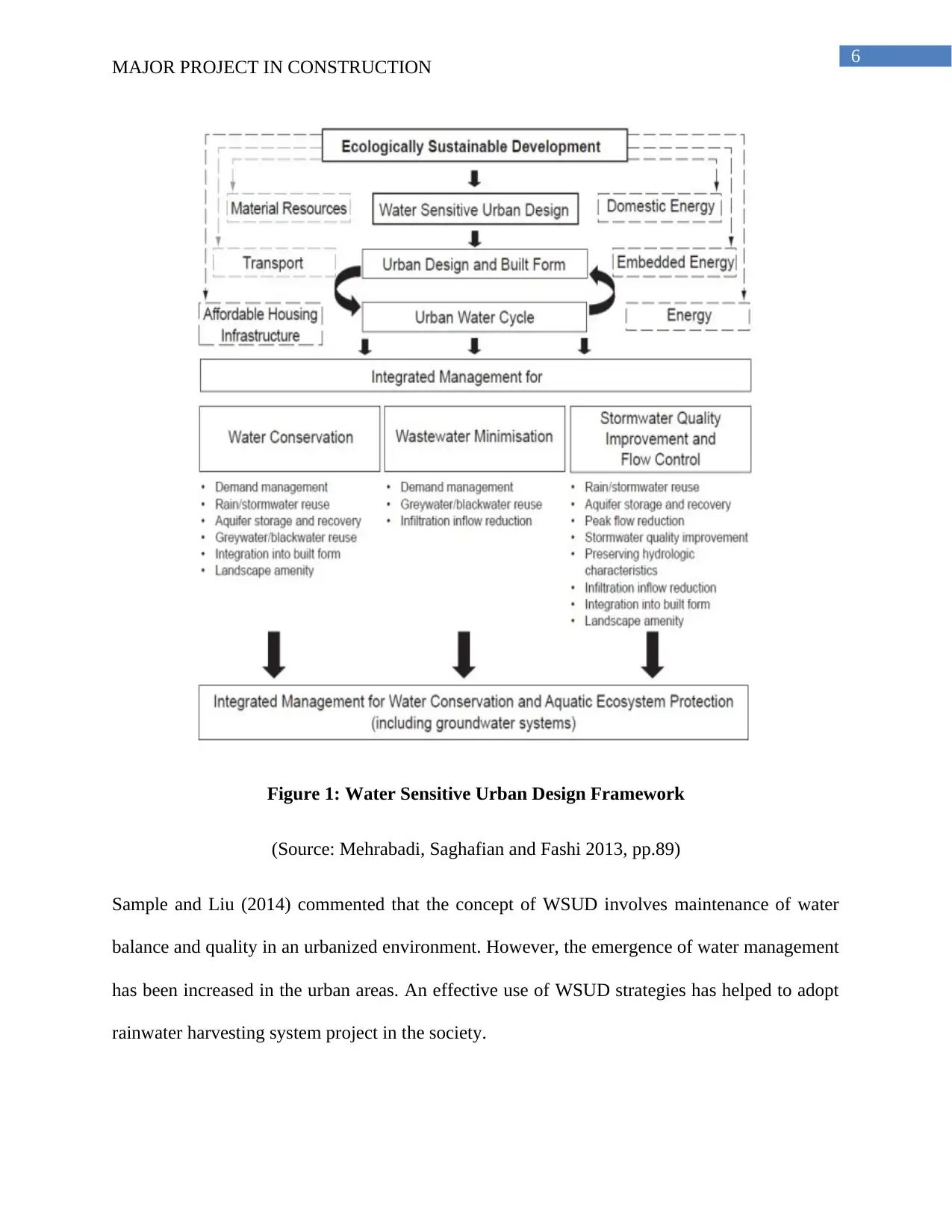
6
MAJOR PROJECT IN CONSTRUCTION
Figure 1: Water Sensitive Urban Design Framework
(Source: Mehrabadi, Saghafian and Fashi 2013, pp.89)
Sample and Liu (2014) commented that the concept of WSUD involves maintenance of water
balance and quality in an urbanized environment. However, the emergence of water management
has been increased in the urban areas. An effective use of WSUD strategies has helped to adopt
rainwater harvesting system project in the society.
MAJOR PROJECT IN CONSTRUCTION
Figure 1: Water Sensitive Urban Design Framework
(Source: Mehrabadi, Saghafian and Fashi 2013, pp.89)
Sample and Liu (2014) commented that the concept of WSUD involves maintenance of water
balance and quality in an urbanized environment. However, the emergence of water management
has been increased in the urban areas. An effective use of WSUD strategies has helped to adopt
rainwater harvesting system project in the society.
Paraphrase This Document
Need a fresh take? Get an instant paraphrase of this document with our AI Paraphraser
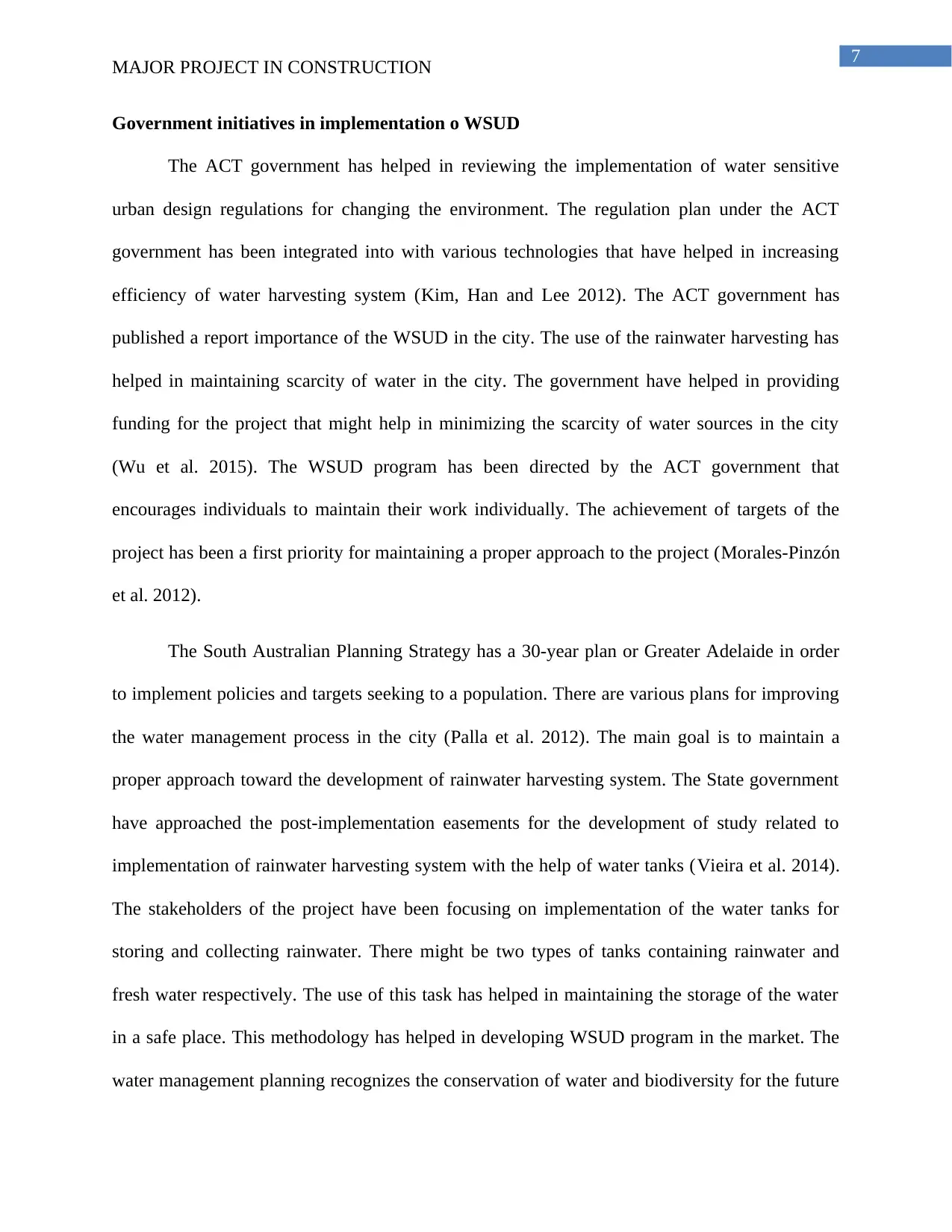
7
MAJOR PROJECT IN CONSTRUCTION
Government initiatives in implementation o WSUD
The ACT government has helped in reviewing the implementation of water sensitive
urban design regulations for changing the environment. The regulation plan under the ACT
government has been integrated into with various technologies that have helped in increasing
efficiency of water harvesting system (Kim, Han and Lee 2012). The ACT government has
published a report importance of the WSUD in the city. The use of the rainwater harvesting has
helped in maintaining scarcity of water in the city. The government have helped in providing
funding for the project that might help in minimizing the scarcity of water sources in the city
(Wu et al. 2015). The WSUD program has been directed by the ACT government that
encourages individuals to maintain their work individually. The achievement of targets of the
project has been a first priority for maintaining a proper approach to the project (Morales-Pinzón
et al. 2012).
The South Australian Planning Strategy has a 30-year plan or Greater Adelaide in order
to implement policies and targets seeking to a population. There are various plans for improving
the water management process in the city (Palla et al. 2012). The main goal is to maintain a
proper approach toward the development of rainwater harvesting system. The State government
have approached the post-implementation easements for the development of study related to
implementation of rainwater harvesting system with the help of water tanks (Vieira et al. 2014).
The stakeholders of the project have been focusing on implementation of the water tanks for
storing and collecting rainwater. There might be two types of tanks containing rainwater and
fresh water respectively. The use of this task has helped in maintaining the storage of the water
in a safe place. This methodology has helped in developing WSUD program in the market. The
water management planning recognizes the conservation of water and biodiversity for the future
MAJOR PROJECT IN CONSTRUCTION
Government initiatives in implementation o WSUD
The ACT government has helped in reviewing the implementation of water sensitive
urban design regulations for changing the environment. The regulation plan under the ACT
government has been integrated into with various technologies that have helped in increasing
efficiency of water harvesting system (Kim, Han and Lee 2012). The ACT government has
published a report importance of the WSUD in the city. The use of the rainwater harvesting has
helped in maintaining scarcity of water in the city. The government have helped in providing
funding for the project that might help in minimizing the scarcity of water sources in the city
(Wu et al. 2015). The WSUD program has been directed by the ACT government that
encourages individuals to maintain their work individually. The achievement of targets of the
project has been a first priority for maintaining a proper approach to the project (Morales-Pinzón
et al. 2012).
The South Australian Planning Strategy has a 30-year plan or Greater Adelaide in order
to implement policies and targets seeking to a population. There are various plans for improving
the water management process in the city (Palla et al. 2012). The main goal is to maintain a
proper approach toward the development of rainwater harvesting system. The State government
have approached the post-implementation easements for the development of study related to
implementation of rainwater harvesting system with the help of water tanks (Vieira et al. 2014).
The stakeholders of the project have been focusing on implementation of the water tanks for
storing and collecting rainwater. There might be two types of tanks containing rainwater and
fresh water respectively. The use of this task has helped in maintaining the storage of the water
in a safe place. This methodology has helped in developing WSUD program in the market. The
water management planning recognizes the conservation of water and biodiversity for the future
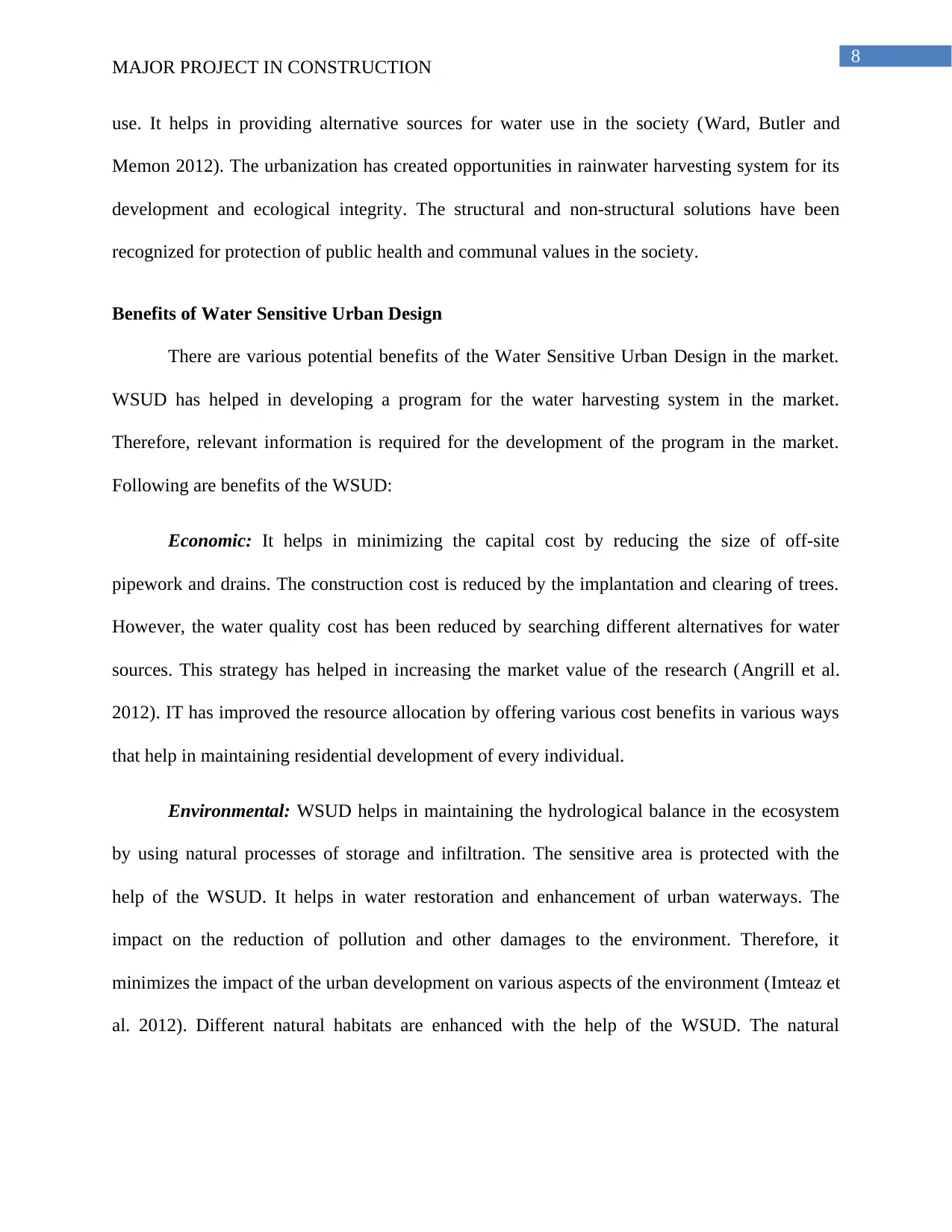
8
MAJOR PROJECT IN CONSTRUCTION
use. It helps in providing alternative sources for water use in the society (Ward, Butler and
Memon 2012). The urbanization has created opportunities in rainwater harvesting system for its
development and ecological integrity. The structural and non-structural solutions have been
recognized for protection of public health and communal values in the society.
Benefits of Water Sensitive Urban Design
There are various potential benefits of the Water Sensitive Urban Design in the market.
WSUD has helped in developing a program for the water harvesting system in the market.
Therefore, relevant information is required for the development of the program in the market.
Following are benefits of the WSUD:
Economic: It helps in minimizing the capital cost by reducing the size of off-site
pipework and drains. The construction cost is reduced by the implantation and clearing of trees.
However, the water quality cost has been reduced by searching different alternatives for water
sources. This strategy has helped in increasing the market value of the research (Angrill et al.
2012). IT has improved the resource allocation by offering various cost benefits in various ways
that help in maintaining residential development of every individual.
Environmental: WSUD helps in maintaining the hydrological balance in the ecosystem
by using natural processes of storage and infiltration. The sensitive area is protected with the
help of the WSUD. It helps in water restoration and enhancement of urban waterways. The
impact on the reduction of pollution and other damages to the environment. Therefore, it
minimizes the impact of the urban development on various aspects of the environment (Imteaz et
al. 2012). Different natural habitats are enhanced with the help of the WSUD. The natural
MAJOR PROJECT IN CONSTRUCTION
use. It helps in providing alternative sources for water use in the society (Ward, Butler and
Memon 2012). The urbanization has created opportunities in rainwater harvesting system for its
development and ecological integrity. The structural and non-structural solutions have been
recognized for protection of public health and communal values in the society.
Benefits of Water Sensitive Urban Design
There are various potential benefits of the Water Sensitive Urban Design in the market.
WSUD has helped in developing a program for the water harvesting system in the market.
Therefore, relevant information is required for the development of the program in the market.
Following are benefits of the WSUD:
Economic: It helps in minimizing the capital cost by reducing the size of off-site
pipework and drains. The construction cost is reduced by the implantation and clearing of trees.
However, the water quality cost has been reduced by searching different alternatives for water
sources. This strategy has helped in increasing the market value of the research (Angrill et al.
2012). IT has improved the resource allocation by offering various cost benefits in various ways
that help in maintaining residential development of every individual.
Environmental: WSUD helps in maintaining the hydrological balance in the ecosystem
by using natural processes of storage and infiltration. The sensitive area is protected with the
help of the WSUD. It helps in water restoration and enhancement of urban waterways. The
impact on the reduction of pollution and other damages to the environment. Therefore, it
minimizes the impact of the urban development on various aspects of the environment (Imteaz et
al. 2012). Different natural habitats are enhanced with the help of the WSUD. The natural
⊘ This is a preview!⊘
Do you want full access?
Subscribe today to unlock all pages.

Trusted by 1+ million students worldwide
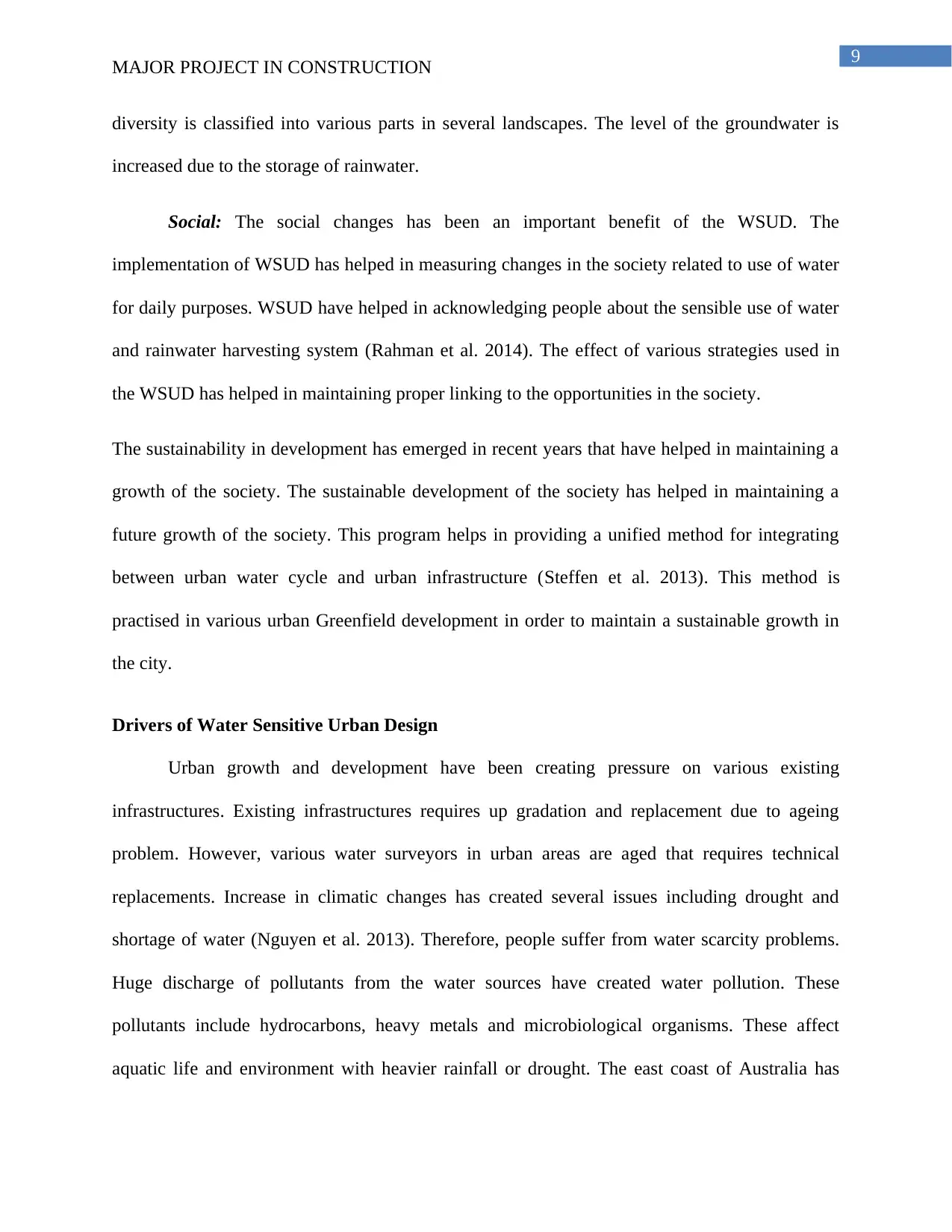
9
MAJOR PROJECT IN CONSTRUCTION
diversity is classified into various parts in several landscapes. The level of the groundwater is
increased due to the storage of rainwater.
Social: The social changes has been an important benefit of the WSUD. The
implementation of WSUD has helped in measuring changes in the society related to use of water
for daily purposes. WSUD have helped in acknowledging people about the sensible use of water
and rainwater harvesting system (Rahman et al. 2014). The effect of various strategies used in
the WSUD has helped in maintaining proper linking to the opportunities in the society.
The sustainability in development has emerged in recent years that have helped in maintaining a
growth of the society. The sustainable development of the society has helped in maintaining a
future growth of the society. This program helps in providing a unified method for integrating
between urban water cycle and urban infrastructure (Steffen et al. 2013). This method is
practised in various urban Greenfield development in order to maintain a sustainable growth in
the city.
Drivers of Water Sensitive Urban Design
Urban growth and development have been creating pressure on various existing
infrastructures. Existing infrastructures requires up gradation and replacement due to ageing
problem. However, various water surveyors in urban areas are aged that requires technical
replacements. Increase in climatic changes has created several issues including drought and
shortage of water (Nguyen et al. 2013). Therefore, people suffer from water scarcity problems.
Huge discharge of pollutants from the water sources have created water pollution. These
pollutants include hydrocarbons, heavy metals and microbiological organisms. These affect
aquatic life and environment with heavier rainfall or drought. The east coast of Australia has
MAJOR PROJECT IN CONSTRUCTION
diversity is classified into various parts in several landscapes. The level of the groundwater is
increased due to the storage of rainwater.
Social: The social changes has been an important benefit of the WSUD. The
implementation of WSUD has helped in measuring changes in the society related to use of water
for daily purposes. WSUD have helped in acknowledging people about the sensible use of water
and rainwater harvesting system (Rahman et al. 2014). The effect of various strategies used in
the WSUD has helped in maintaining proper linking to the opportunities in the society.
The sustainability in development has emerged in recent years that have helped in maintaining a
growth of the society. The sustainable development of the society has helped in maintaining a
future growth of the society. This program helps in providing a unified method for integrating
between urban water cycle and urban infrastructure (Steffen et al. 2013). This method is
practised in various urban Greenfield development in order to maintain a sustainable growth in
the city.
Drivers of Water Sensitive Urban Design
Urban growth and development have been creating pressure on various existing
infrastructures. Existing infrastructures requires up gradation and replacement due to ageing
problem. However, various water surveyors in urban areas are aged that requires technical
replacements. Increase in climatic changes has created several issues including drought and
shortage of water (Nguyen et al. 2013). Therefore, people suffer from water scarcity problems.
Huge discharge of pollutants from the water sources have created water pollution. These
pollutants include hydrocarbons, heavy metals and microbiological organisms. These affect
aquatic life and environment with heavier rainfall or drought. The east coast of Australia has
Paraphrase This Document
Need a fresh take? Get an instant paraphrase of this document with our AI Paraphraser
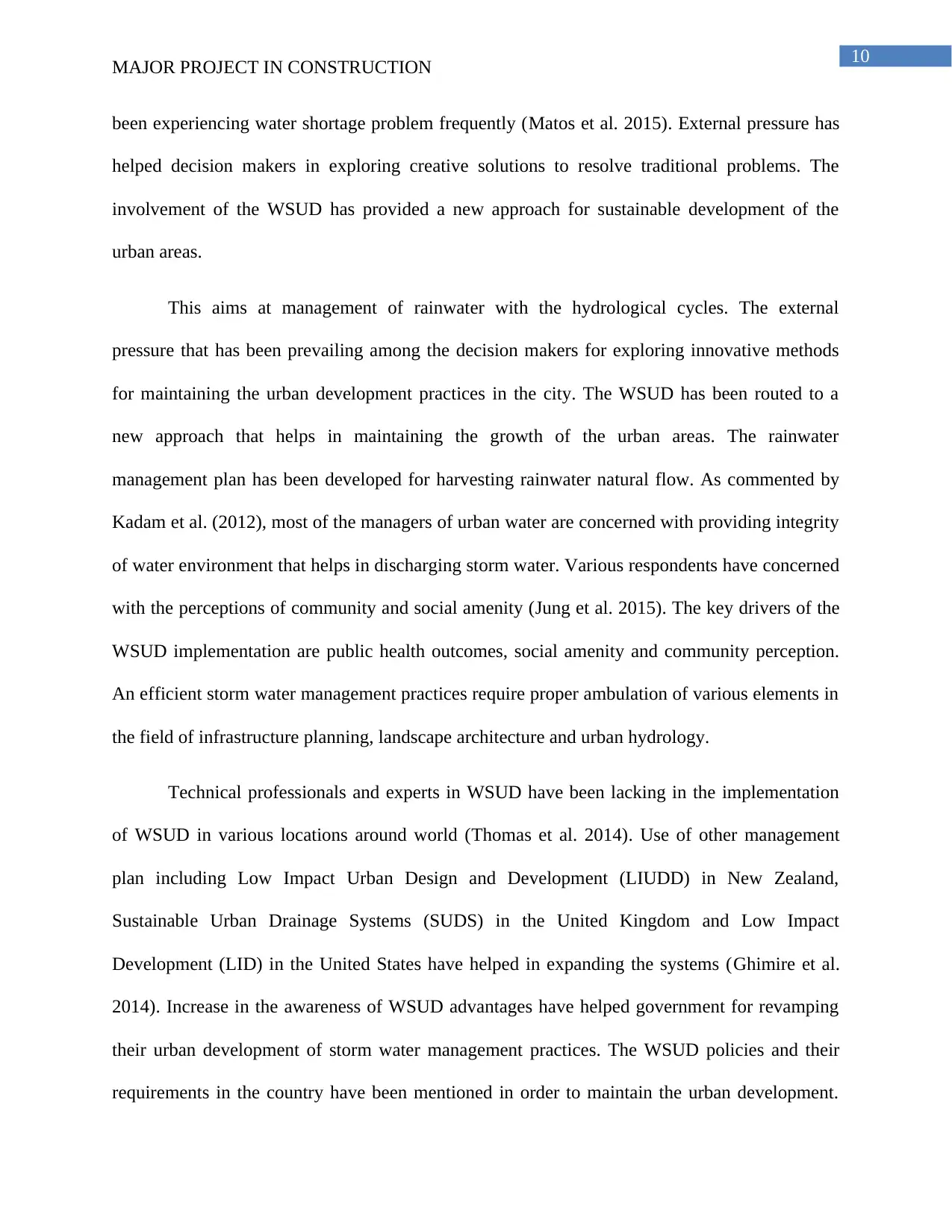
10
MAJOR PROJECT IN CONSTRUCTION
been experiencing water shortage problem frequently (Matos et al. 2015). External pressure has
helped decision makers in exploring creative solutions to resolve traditional problems. The
involvement of the WSUD has provided a new approach for sustainable development of the
urban areas.
This aims at management of rainwater with the hydrological cycles. The external
pressure that has been prevailing among the decision makers for exploring innovative methods
for maintaining the urban development practices in the city. The WSUD has been routed to a
new approach that helps in maintaining the growth of the urban areas. The rainwater
management plan has been developed for harvesting rainwater natural flow. As commented by
Kadam et al. (2012), most of the managers of urban water are concerned with providing integrity
of water environment that helps in discharging storm water. Various respondents have concerned
with the perceptions of community and social amenity (Jung et al. 2015). The key drivers of the
WSUD implementation are public health outcomes, social amenity and community perception.
An efficient storm water management practices require proper ambulation of various elements in
the field of infrastructure planning, landscape architecture and urban hydrology.
Technical professionals and experts in WSUD have been lacking in the implementation
of WSUD in various locations around world (Thomas et al. 2014). Use of other management
plan including Low Impact Urban Design and Development (LIUDD) in New Zealand,
Sustainable Urban Drainage Systems (SUDS) in the United Kingdom and Low Impact
Development (LID) in the United States have helped in expanding the systems (Ghimire et al.
2014). Increase in the awareness of WSUD advantages have helped government for revamping
their urban development of storm water management practices. The WSUD policies and their
requirements in the country have been mentioned in order to maintain the urban development.
MAJOR PROJECT IN CONSTRUCTION
been experiencing water shortage problem frequently (Matos et al. 2015). External pressure has
helped decision makers in exploring creative solutions to resolve traditional problems. The
involvement of the WSUD has provided a new approach for sustainable development of the
urban areas.
This aims at management of rainwater with the hydrological cycles. The external
pressure that has been prevailing among the decision makers for exploring innovative methods
for maintaining the urban development practices in the city. The WSUD has been routed to a
new approach that helps in maintaining the growth of the urban areas. The rainwater
management plan has been developed for harvesting rainwater natural flow. As commented by
Kadam et al. (2012), most of the managers of urban water are concerned with providing integrity
of water environment that helps in discharging storm water. Various respondents have concerned
with the perceptions of community and social amenity (Jung et al. 2015). The key drivers of the
WSUD implementation are public health outcomes, social amenity and community perception.
An efficient storm water management practices require proper ambulation of various elements in
the field of infrastructure planning, landscape architecture and urban hydrology.
Technical professionals and experts in WSUD have been lacking in the implementation
of WSUD in various locations around world (Thomas et al. 2014). Use of other management
plan including Low Impact Urban Design and Development (LIUDD) in New Zealand,
Sustainable Urban Drainage Systems (SUDS) in the United Kingdom and Low Impact
Development (LID) in the United States have helped in expanding the systems (Ghimire et al.
2014). Increase in the awareness of WSUD advantages have helped government for revamping
their urban development of storm water management practices. The WSUD policies and their
requirements in the country have been mentioned in order to maintain the urban development.
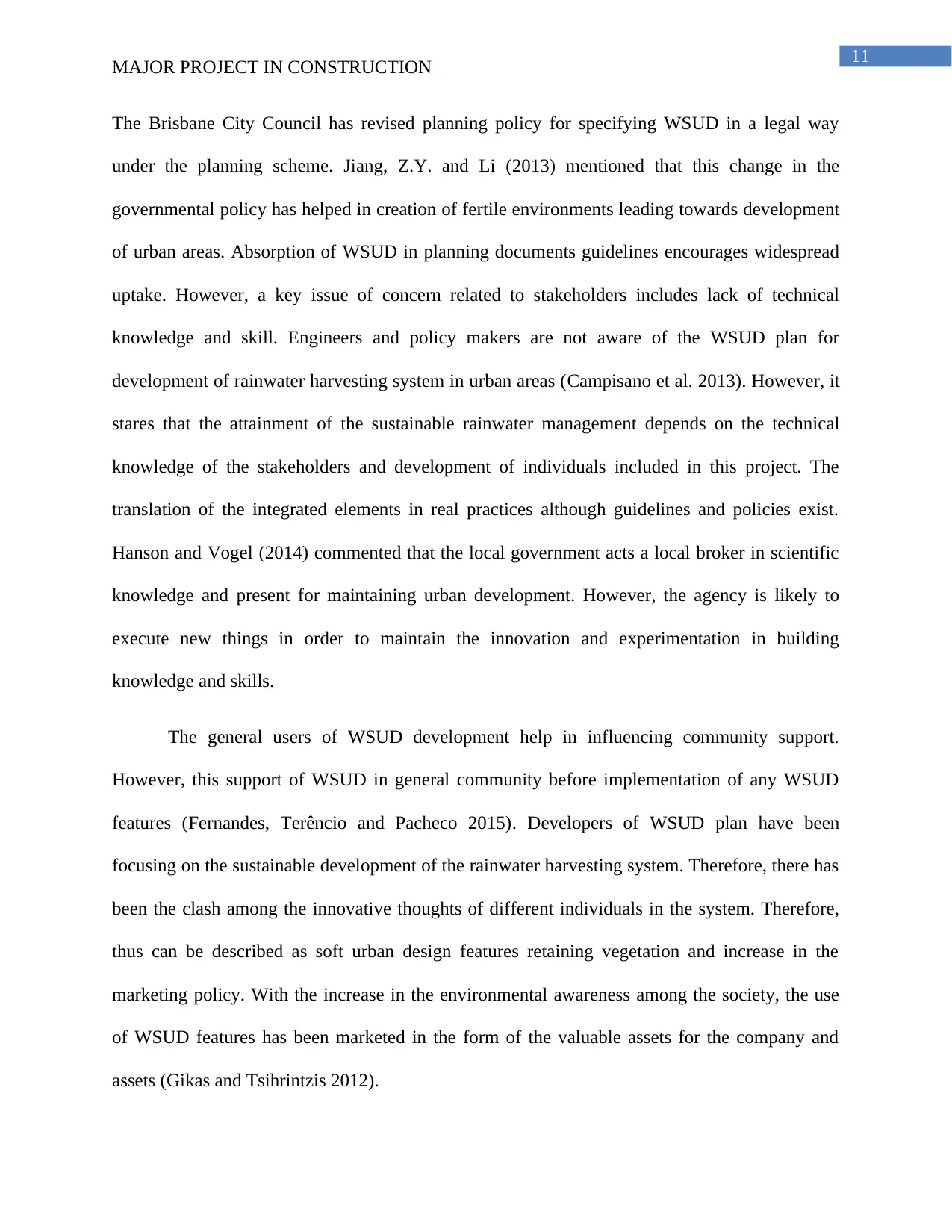
11
MAJOR PROJECT IN CONSTRUCTION
The Brisbane City Council has revised planning policy for specifying WSUD in a legal way
under the planning scheme. Jiang, Z.Y. and Li (2013) mentioned that this change in the
governmental policy has helped in creation of fertile environments leading towards development
of urban areas. Absorption of WSUD in planning documents guidelines encourages widespread
uptake. However, a key issue of concern related to stakeholders includes lack of technical
knowledge and skill. Engineers and policy makers are not aware of the WSUD plan for
development of rainwater harvesting system in urban areas (Campisano et al. 2013). However, it
stares that the attainment of the sustainable rainwater management depends on the technical
knowledge of the stakeholders and development of individuals included in this project. The
translation of the integrated elements in real practices although guidelines and policies exist.
Hanson and Vogel (2014) commented that the local government acts a local broker in scientific
knowledge and present for maintaining urban development. However, the agency is likely to
execute new things in order to maintain the innovation and experimentation in building
knowledge and skills.
The general users of WSUD development help in influencing community support.
However, this support of WSUD in general community before implementation of any WSUD
features (Fernandes, Terêncio and Pacheco 2015). Developers of WSUD plan have been
focusing on the sustainable development of the rainwater harvesting system. Therefore, there has
been the clash among the innovative thoughts of different individuals in the system. Therefore,
thus can be described as soft urban design features retaining vegetation and increase in the
marketing policy. With the increase in the environmental awareness among the society, the use
of WSUD features has been marketed in the form of the valuable assets for the company and
assets (Gikas and Tsihrintzis 2012).
MAJOR PROJECT IN CONSTRUCTION
The Brisbane City Council has revised planning policy for specifying WSUD in a legal way
under the planning scheme. Jiang, Z.Y. and Li (2013) mentioned that this change in the
governmental policy has helped in creation of fertile environments leading towards development
of urban areas. Absorption of WSUD in planning documents guidelines encourages widespread
uptake. However, a key issue of concern related to stakeholders includes lack of technical
knowledge and skill. Engineers and policy makers are not aware of the WSUD plan for
development of rainwater harvesting system in urban areas (Campisano et al. 2013). However, it
stares that the attainment of the sustainable rainwater management depends on the technical
knowledge of the stakeholders and development of individuals included in this project. The
translation of the integrated elements in real practices although guidelines and policies exist.
Hanson and Vogel (2014) commented that the local government acts a local broker in scientific
knowledge and present for maintaining urban development. However, the agency is likely to
execute new things in order to maintain the innovation and experimentation in building
knowledge and skills.
The general users of WSUD development help in influencing community support.
However, this support of WSUD in general community before implementation of any WSUD
features (Fernandes, Terêncio and Pacheco 2015). Developers of WSUD plan have been
focusing on the sustainable development of the rainwater harvesting system. Therefore, there has
been the clash among the innovative thoughts of different individuals in the system. Therefore,
thus can be described as soft urban design features retaining vegetation and increase in the
marketing policy. With the increase in the environmental awareness among the society, the use
of WSUD features has been marketed in the form of the valuable assets for the company and
assets (Gikas and Tsihrintzis 2012).
⊘ This is a preview!⊘
Do you want full access?
Subscribe today to unlock all pages.

Trusted by 1+ million students worldwide
1 out of 30
Related Documents
Your All-in-One AI-Powered Toolkit for Academic Success.
+13062052269
info@desklib.com
Available 24*7 on WhatsApp / Email
![[object Object]](/_next/static/media/star-bottom.7253800d.svg)
Unlock your academic potential
Copyright © 2020–2025 A2Z Services. All Rights Reserved. Developed and managed by ZUCOL.





